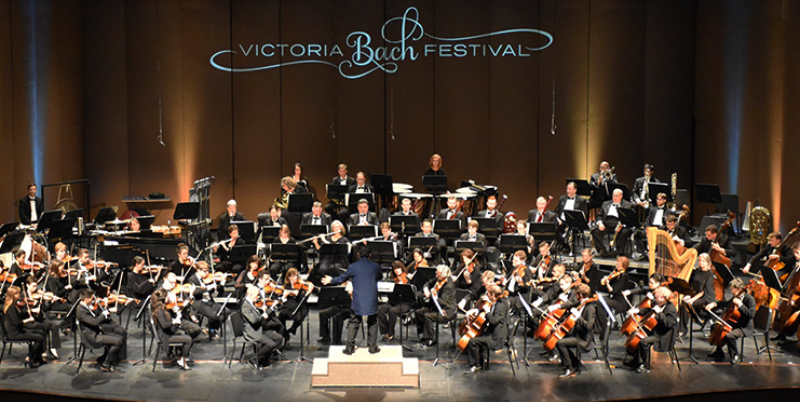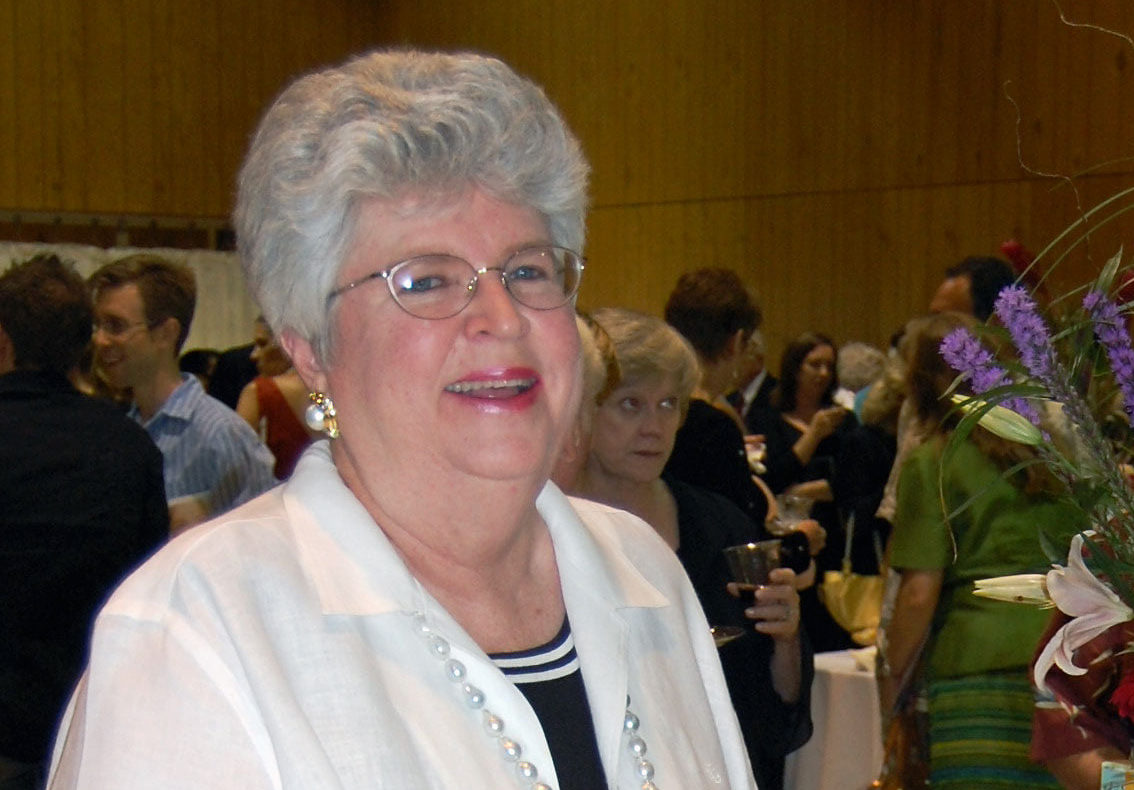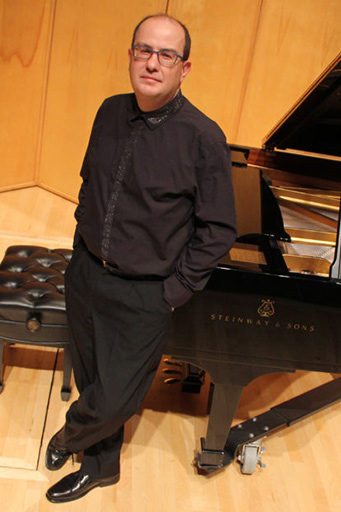REEMERGENCE: TCHAIKOVSKY’S FIFTH SYMPHONY
Saturday, June 11, 2022 | 7:30 PM
Victoria Fine Arts Center
1002 Sam Houston Drive
JESSIE MONTGOMERY (b. 1981)
Starburst
PYOTR ILYICH TCHAIKOVSKY (1840 – 1893)
Piano Concerto No. 1 n B♭ minor, Op. 23
- Allegro non troppo e molto maestoso – Allegro con spirito
- Andantino semplice – Prestissimo
- Allegro con fuoco
Alexandre Dossin, piano
INTERMISSION
PYOTR ILYICH TCHAIKOVSKY
Symphony No. 5 in E minor, Op. 64
- Andante—Allegro con anima
- Andante cantabile, con alcuna licenza
- Valse. Allegro moderato
- Finale. Andante maestoso—Allegro vivace
Victoria Bach Festival Orchestra
Alejandro Hernandez-Valdez, conductor
VBF Orchestra
VIOLIN I
Stephen Redfield, concertmaster
Jackson Guillen
Patrice Calixte
Joseph Smith
Sonja Larson
Helen Cooper
Bruce Colson
Caleb Polashek
Elise Winters
Maria Lin
Joan Carlson
Megan Zapfe
VIOLIN II
Corinne Stillwell, principal
Juan Jaramillo
Melissa Balli
Susan Doering
Christabel Lin
Beth Blackerby
Turner Partain
Boel Gidholm
Jann Cosart
Katie McCoy
Karen Stiles
VIOLA
Bruce Williams, principal
Suzanna Giordano-Gignac
Caitlin Lynch
Ames Asbell
Désirée Elsevier
Melissa Brewer
Brett Detweiler
CELLO
Douglas Harvey, principal
Christopher Haritatos
Yi Qun Xu
Anna Park
Justin Balli
Shawn Sanders
DOUBLE BASS
Melanie Punter, principal
Andrew Potter
Jonathan Rouse
Patrick de los Santos
FLUTE
Adah Toland Jones, principal
Rita Linard
Hilary Janysek, piccolo
OBOE
Ian Davidson, principal
Michael Johnson
CLARINET
Vanguel Tangarov, principal
Hilary Scop
BASSOON
Kristen Wolfe Jensen, principal
Daniel Chrisman
FRENCH HORN
Peter Rubins, principal
Pat Hughes
Lauren Piccione
Jill Rodriguez
TRUMPET
Chris Carrillo, principal
Ron Ledbetter
TROMBONE
Javier Stuppard, principal
Owen Homayoun
Martin McCain
TUBA
Raúl I. Rodríguez, principal
TIMPANI
Riely Francis, principal


Tonight’s concert is dedicated to Janet Miller, whose dedication and steadfast support helped transform the Victoria Bach Festival.
Sponsors
Janey & Melvin Lack
This concert is generously supported by our concert sponsors and by donors to the Victoria Bach Festival’s Annual Fund. Many thanks to our generous supporters!
Jessie Montgomery (b 1981), a native New Yorker educated at Juilliard and New York University, is an ASCAP Award-winning composer and violinist. In 2021, she served as composer-in-residence for the Chicago Symphony. Her works have been commissioned by the National Choral Society, Orpheus Chamber Orchestra, and the Metropolitan Museum of Art. They are known for reflecting a broad scope of influences from modern jazz through Zimbabwean dance and renaissance ensemble music.
Although premiered as an encore for the Sphinx ensemble, Montgomery envisioned “Starburst” as a fanfare, the role it serves on this program. In a verbal program note on YouTube, she explains her intent to explore the “colors, articulations, and gestures that are unique to the string ensemble,” to produce an effect that is “explosive, celebratory, fiery, and energetic.” To this can be added “bold” and “playfully outgoing.”
In marked contrast to “Starburst,” Pyotr Tchaikovsky’s first of three piano concertos explores the somber tension of internal conflict. Hans von Bülow, noted pianist and conductor, premiered the work at a time when many Russian intellectuals saw his music as too strongly influenced by Western Europe. Nationalism, the recognition of music from the composer’s own cultural heritage, was the order of the day. But performers like von Bülow, patrons like Nadezhda von Meck, and advocates like famed writer Fyodr Dostoevsky promoted the continental inclusiveness of his works as a positive trait. Unlike many composers, these accolades made it possible for Tchaikovsky to achieve success in his own time.
This piano concerto, with its unusually short introduction, is one of the most famous of all time due, in part, to its later use in a variety of popular culture settings. Composed in 1875, it has since been heard as the theme music of Orson Welles’ radio series, in a comedy sketch by Monty Python, in the film Misery, and in cartoons for Merrie Melodies and Spongebob Squarepants. But despite these sometimes light-hearted treatments, often stereotyping music of the Romantic era, the concerto remains a powerful work with deeply passionate emotional resonance. The first movement successfully joins folk songs from both his native Russia and from Ukraine, using standard classical forms undergirded with the progressive harmonies that had earned him criticism from some Russian nationalists.
The second movement begins with the delicacy of a flute solo, the piano smoothly joining in the lovely pastoral mood that, appropriately, features the woodwinds. It is here that Tchaikovsky’s signature control of tone color shimmers its brightest. The third movement takes off, repeatedly returning to its con fuoco and con vivo, “fiery” and “lively” themes from lyrical breathing spells. The entire concerto foreshadows the tenderness and strength that would grow even further nearly twenty years later in 1892’s Nutcracker.
Tchaikovsky’s Symphony No. 5, like Beethoven’s symphony of the same number, is one of the most challenging and rewarding in the symphonic repertoire. Both keep the traditional four-movement form. One major, and rather unusual, similarity to Beethoven’s fifth is Tchaikovsky’s use of a theme that occurs in all four movements. And, like Beethoven, he uses the third movement to walk away from tradition: Mozart and Haydn usually wrote elegant minuets, Beethoven kept the same ABA form, but changed styles to the energetic scherzo. Tchaikovsky also kept the form, but used the waltz, the most prominent dance of his era, as his third movement, ending with a dynamic finale moving from twilight to fireworks in the depth of night—a fitting complement to the Jessie Montgomery’s fanfare that opens this program.
Montgomery Lights the Night Sky for Tchaikovsky
Jessie Montgomery (b 1981), a native New Yorker educated at Juilliard and New York University, is an ASCAP Award-winning composer and violinist. In 2021, she served as composer-in-residence for the Chicago Symphony. Her works have been commissioned by the National Choral Society, Orpheus Chamber Orchestra, and the Metropolitan Museum of Art. They are known for reflecting a broad scope of influences from modern jazz through Zimbabwean dance and renaissance ensemble music.
Although premiered as an encore for the Sphinx ensemble, Montgomery envisioned “Starburst” as a fanfare, the role it serves on this program. In a verbal program note on YouTube, she explains her intent to explore the “colors, articulations, and gestures that are unique to the string ensemble,” to produce an effect that is “explosive, celebratory, fiery, and energetic.” To this can be added “bold” and “playfully outgoing.”
In marked contrast to “Starburst,” Pyotr Tchaikovsky’s first of three piano concertos explores the somber tension of internal conflict. Hans von Bülow, noted pianist and conductor, premiered the work at a time when many Russian intellectuals saw his music as too strongly influenced by Western Europe. Nationalism, the recognition of music from the composer’s own cultural heritage, was the order of the day. But performers like von Bülow, patrons like Nadezhda von Meck, and advocates like famed writer Fyodr Dostoevsky promoted the continental inclusiveness of his works as a positive trait. Unlike many composers, these accolades made it possible for Tchaikovsky to achieve success in his own time.
This piano concerto, with its unusually short introduction, is one of the most famous of all time due, in part, to its later use in a variety of popular culture settings. Composed in 1875, it has since been heard as the theme music of Orson Welles’ radio series, in a comedy sketch by Monty Python, in the film Misery, and in cartoons for Merrie Melodies and Spongebob Squarepants. But despite these sometimes light-hearted treatments, often stereotyping music of the Romantic era, the concerto remains a powerful work with deeply passionate emotional resonance. The first movement successfully joins folk songs from both his native Russia and from Ukraine, using standard classical forms undergirded with the progressive harmonies that had earned him criticism from some Russian nationalists.
The second movement begins with the delicacy of a flute solo, the piano smoothly joining in the lovely pastoral mood that, appropriately, features the woodwinds. It is here that Tchaikovsky’s signature control of tone color shimmers its brightest. The third movement takes off, repeatedly returning to its con fuoco and con vivo, “fiery” and “lively” themes from lyrical breathing spells. The entire concerto foreshadows the tenderness and strength that would grow even further nearly twenty years later in 1892’s Nutcracker.
Tchaikovsky’s Symphony No. 5, like Beethoven’s symphony of the same number, is one of the most challenging and rewarding in the symphonic repertoire. Both keep the traditional four-movement form. One major, and rather unusual, similarity to Beethoven’s fifth is Tchaikovsky’s use of a theme that occurs in all four movements. And, like Beethoven, he uses the third movement to walk away from tradition: Mozart and Haydn usually wrote elegant minuets, Beethoven kept the same ABA form, but changed styles to the energetic scherzo. Tchaikovsky also kept the form, but used the waltz, the most prominent dance of his era, as his third movement, ending with a dynamic finale moving from twilight to fireworks in the depth of night—a fitting complement to the Jessie Montgomery’s fanfare that opens this program.
–Dr. Yvonne Kendall, © 2022
About the Artists

Alejandro Hernandez-Valdez, conductor
New York, New York
Esteemed conductor and pianist Dr. Alejandro Hernandez-Valdez was named Artistic Director of Musica Viva NY and Director of Music of the historic Unitarian Church of All Souls in Manhattan in 2015. He is also Co-Founder of the New Orchestra of Washington and Artistic Director of the Victoria Bach Festival. He has earned accolades from The Washington Post as a conductor “with the incisive clarity of someone born to the idiom,” as well as praise from The New York Times for leading “a stirring performance” of Brahms’ Ein Deutsches Requiem. His guest conducting engagements include appearances at The Kennedy Center in Washington, D.C., Lincoln Center in New York City, and the Degollado Theatre in Guadalajara, Mexico, where he led the Jalisco Philharmonic. As a pianist, Hernandez-Valdez performed for the 2013 Britten 100 festival in New York, organized by the Britten-Pears Foundation to honor the 100th anniversary of the titular composer’s birth. Read full bio

Alexandre Dossin, piano
Considered an “extraordinary musician” by Martha Argerich, critically acclaimed Steinway Artist Alexandre Dossin enjoys active performing, recording and teaching careers. Dossin is professor of piano and chair of piano at the University of Oregon School of Music, and is also on the faculty at the University of Melbourne Conservatorium of Music.
Originally from Brazil, Dossin is a graduate of the Moscow Tchaikovsky Conservatory, and holds a doctorate degree from the University of Texas at Austin. He served as assistant for Sergei Dorensky at the Tchaikovsky Conservatory, and William Race and Gregory Allen at UT, Austin.
A prizewinner of several international piano competitions, Dossin received First Prize and the Special Prize at the 2003 Martha Argerich International Piano Competition in Buenos Aires. Other international awards include the Silver Medal and Second Honourable Mention at the Maria Callas Grand Prix, and Third Prize and the Special Prize at the ‘W.A. Mozart’ International Piano Competition, in addition to several awards from competitions in Brazil.
An active recording artist, his discography comprises 15 albums released across several labels, including seven albums with Naxos and six editions/recordings for G. Schirmer. His work has been praised in numerous international publications including Diapason, Financial Times, Fanfare, American Record Guide and Clavier.
Dossin is vice president of The American Liszt Society, president of the Oregon Chapter of The American Liszt Society, and is a recipient of the prestigious Fund for Faculty Excellence at the University of Oregon.
For more information, visit www.dossin.net.
See our full 2022 artist list for additional biographical information.



